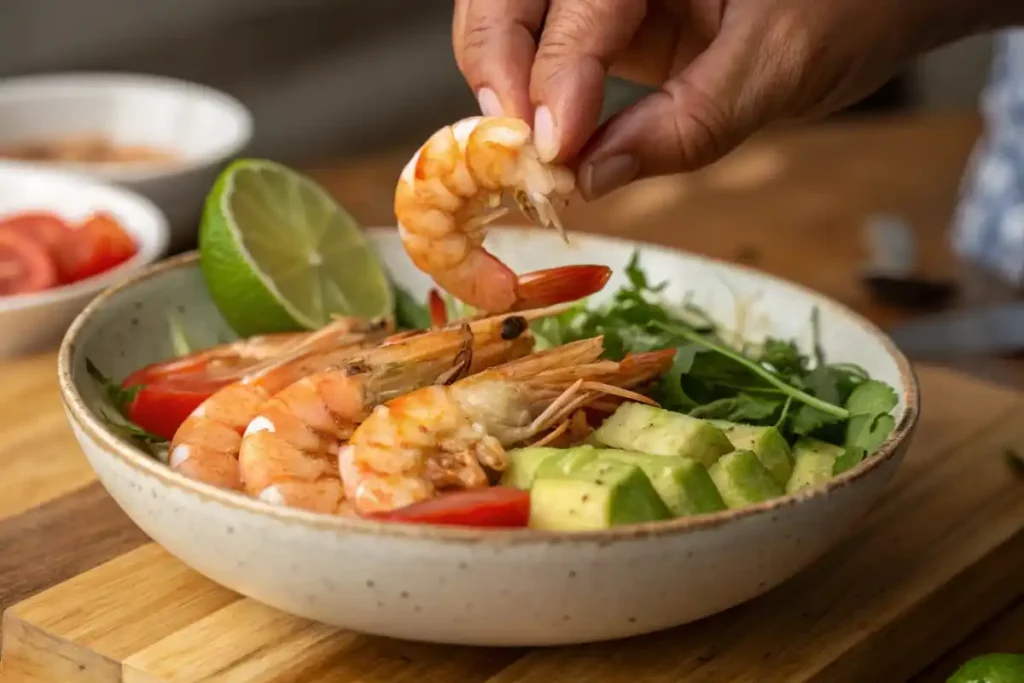Tiger shrimp, also known as Penaeus monodon, are a popular seafood choice worldwide. This article explores their taste, nutritional benefits, and culinary uses. Additionally, we’ll discuss their environmental impact, safety concerns, and economic factors. By the end, you’ll have a comprehensive understanding of whether these crustaceans are a good addition to your diet.
1. Introduction to Tiger Shrimp
Overview of Penaeus monodon
Tiger shrimp, or Penaeus monodon, are large marine crustaceans that are widely cultivated for food. They are known for their distinctive black and white stripes, which give them their name. These shrimp are primarily found in the Indo-Pacific region and are a staple in many cuisines. Their popularity stems from their sweet, succulent meat, making them a favorite among seafood lovers. Moreover, they are often farmed due to their rapid growth and high market demand. Understanding their characteristics and culinary uses can help you appreciate why they are so sought after.
Nutritional Value
When considering whether tiger shrimp are good to eat, it’s essential to look at their nutritional profile. These shrimp are low in calories yet high in protein, making them an excellent choice for health-conscious individuals. A typical serving provides a good amount of omega-3 fatty acids, which are beneficial for heart health. Additionally, they contain essential vitamins and minerals, such as vitamin B12, selenium, and iodine. However, it’s important to be mindful of their cholesterol content, as it can be relatively high. Balancing your diet with a variety of seafood can help you enjoy the benefits of tiger shrimp while managing your overall health.
2. Taste and Culinary Uses
What Do Tiger Shrimp Taste Like?
When it comes to flavor, tiger shrimp are often praised for their sweet, delicate taste. Their meat is firm yet tender, making it a delightful addition to various dishes. Many people describe the flavor as slightly briny, reminiscent of the ocean, which enhances its appeal. Moreover, the texture holds up well to different cooking methods, whether grilled, sautéed, or boiled. Consequently, they can absorb flavors from marinades and spices beautifully, making them versatile in the kitchen. If you’re wondering about their culinary potential, you’ll find that they can elevate any meal with their unique taste.
Popular Dishes Featuring Tiger Shrimp
Chefs around the world love using tiger shrimp in their cuisines. From spicy shrimp tacos to creamy shrimp pasta, the possibilities are endless. In Asian cooking, cooks often feature them in stir-fries or serve them with rice and vegetables, allowing their flavor to shine. Additionally, you can grill them on skewers for a perfect summer barbecue dish. Many chefs also enjoy adding them to seafood paella or gumbo, where their robust flavor complements other ingredients. With such a wide range of dishes, it’s easy to see why seafood lovers choose tiger shrimp so often.

3. Health Benefits and Risks
Are Tiger Shrimp Safe to Eat?
When considering whether tiger shrimp are good to eat, safety is a crucial factor. Generally, these shrimp are safe for consumption, but there are some important points to keep in mind. First, ensure that they are sourced from reputable suppliers to avoid contamination. Wild-caught shrimp may have lower risks of disease compared to farmed ones, which can sometimes carry pathogens. Additionally, it’s wise to be cautious about allergies, as shellfish can trigger reactions in some individuals. Cooking shrimp thoroughly is essential to eliminate any harmful bacteria, ensuring a safe and enjoyable dining experience.
Health Benefits of Eating Tiger Shrimp
Incorporating tiger shrimp into your diet can offer several health benefits. As mentioned earlier, they are rich in protein, which is vital for muscle growth and repair. Furthermore, their high omega-3 fatty acid content supports heart health and may reduce inflammation. Additionally, shrimp are low in calories, making them an excellent option for those looking to maintain a healthy weight. They also provide essential nutrients like vitamin B12 and selenium, which play important roles in energy production and immune function. Thus, enjoying tiger shrimp can be a delicious way to boost your overall health.
4. Environmental Impact and Sustainability
Aquaculture Practices
Farming tiger shrimp, known as aquaculture, offers both benefits and drawbacks. On one hand, it supplies a steady stream of shrimp to meet global demand. However, some farming methods can lead to environmental issues. For instance, shrimp farms often clear large areas of mangrove forests, which harms local ecosystems. Moreover, some farming practices use chemicals and antibiotics, raising concerns about water pollution. Consequently, you should choose shrimp from sustainable sources that prioritize eco-friendly practices. This way, you can enjoy your meal while supporting the health of our oceans.
Sustainable Consumption
When you consider whether tiger shrimp are good to eat, sustainability plays a vital role. Many organizations, like the Marine Stewardship Council, certify seafood that responsible harvesters catch. By looking for these labels, you can make informed choices that support sustainable fishing and farming practices. Additionally, opting for shrimp from certified farms helps reduce the negative impact on marine life. Furthermore, being aware of shrimp seasonality can guide your purchasing decisions. By doing so, you contribute to a more sustainable seafood industry, ensuring that future generations can enjoy these delicious crustaceans.

5. Economic Aspects
Why Are Tiger Shrimp So Expensive?
The price of tiger shrimp can be quite high, and several factors contribute to this. First, the cost of farming and harvesting shrimp is significant, especially when considering the need for quality feed and disease management. Moreover, the demand for tiger shrimp often exceeds supply, particularly in markets where they are considered a delicacy. Consequently, this high demand drives up prices. Additionally, factors like transportation and import tariffs can further increase costs. Understanding these economic aspects can help consumers appreciate the value of tiger shrimp when they see them on restaurant menus or in grocery stores.
The Global Shrimp Industry
The shrimp industry is a major player in the global seafood market, with tiger shrimp being one of the most sought-after species. In recent years, the industry has seen significant growth, driven by rising consumer demand for seafood. However, this growth comes with challenges, such as ensuring sustainable practices and managing disease outbreaks in farms. Furthermore, the economic impact of shrimp farming extends beyond just the seafood market; it also supports local economies and provides jobs in many regions. By understanding the dynamics of the shrimp industry, consumers can make more informed choices about their seafood consumption.
6. FAQs
1. What do tiger shrimp taste like?
Tiger shrimp are known for their sweet, succulent flavor, which many describe as slightly briny and reminiscent of the ocean. Their firm yet tender texture makes them a delightful addition to various dishes. When cooked, they absorb flavors from marinades and spices well, enhancing their taste. This unique flavor profile is one reason why many seafood lovers consider them a premium choice. Overall, they offer a delicious experience for any meal.
2. What is the difference between tiger shrimp and regular shrimp?
The primary difference between tiger shrimp and regular shrimp lies in their size and flavor. Tiger shrimp, or Penaeus monodon, are generally larger and have a more robust, sweet taste compared to smaller shrimp varieties. Additionally, their distinctive black and white stripes set them apart visually. While regular shrimp can be milder in flavor, tiger shrimp’s unique taste makes them a favorite in many culinary applications, adding depth to various dishes.
3. Are tiger shrimp safe to eat?
Yes, you can generally enjoy tiger shrimp safely if you source them from reputable suppliers. However, you must cook them thoroughly to eliminate any harmful bacteria. Additionally, some individuals may have shellfish allergies, so it’s wise to exercise caution. By sourcing shrimp from sustainable farms, you can also lower the risk of contamination. Overall, when you prepare tiger shrimp correctly, they become a delicious and safe seafood option.
Why Are Tiger Shrimp So Expensive?
Several factors drive up the price of tiger shrimp. First, farming and harvesting these shrimp incurs significant costs, especially due to the need for quality feed and effective disease management. Moreover, high demand for tiger shrimp often exceeds supply, particularly in markets where people consider them a delicacy. Consequently, these factors lead to their higher price compared to other seafood options.
Conclusion
In conclusion, the question of whether tiger shrimp are good to eat can be answered with a resounding yes. Their sweet flavor, firm texture, and nutritional benefits make them a popular choice among seafood enthusiasts. However, it’s crucial to consider sustainability and sourcing when enjoying these crustaceans. By choosing shrimp from reputable suppliers, you can enjoy their delicious taste while supporting responsible practices. For more information on tiger shrimp, you can visit the Wikipedia page on Penaeus monodon. Additionally, if you’re looking for more delicious recipes, check out our seafood boil sauce recipe or explore our venison roast recipe. With the right choices, you can savor the delightful taste of tiger shrimp while being mindful of your health and the environment.

